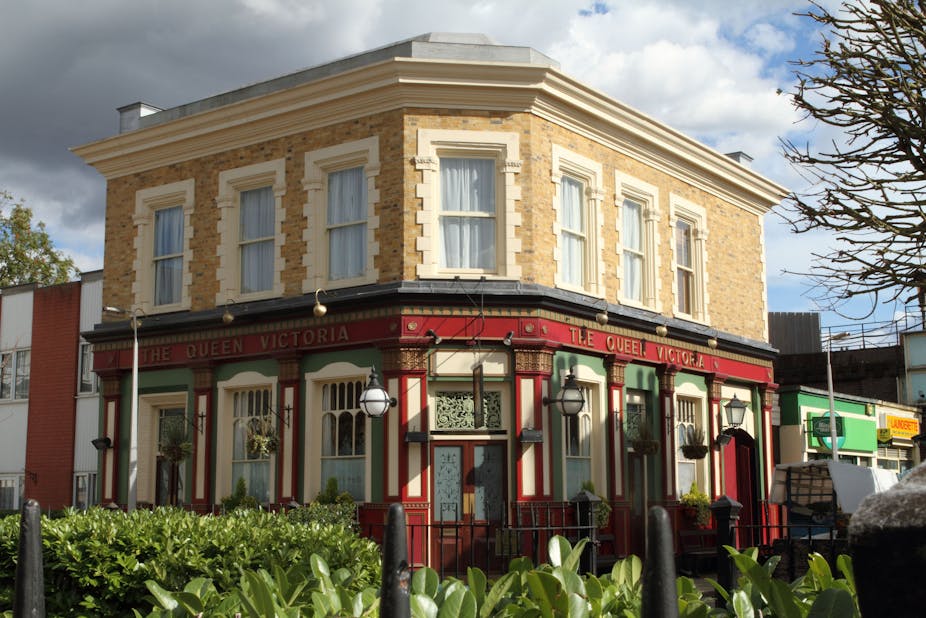In the US, television programmes have traditionally been designed to be aspirational. This is largely due to an advertising model that likes to think of audiences as consumers and sell them the latest desirable gadgets alongside their daily dose of soap, sitcom and drama.
UK television, on the other hand, with its public service tradition, is bound up with issues of class, of reflecting everyday society in what can only be described as a more “downbeat” way.
Hence, American audiences got Dallas and Dynasty, while us Brits settle for Coronation Street and Eastenders. What Neighbours and Home and Away say about Australia, with escapist plots and never-ending sunshine, is something I’ll leave for another time.
So the announcement this week about the gentrification of Eastenders was bound to generate headlines. New executive producer Dominic Treadwell-Collins revealed that the “edges of Shoreditch” would begin to creep into the show to reflect the economic changes that have occurred in East London since the soap was first broadcast in 1985.
For those not intimately familiar with the layout of the London Borough of Hackney, Shoreditch is a former industrial area that experienced rapid urban regeneration following an influx of young artists, musicians and creatives in the 1990s. They were initially attracted to the cheap and flexible warehouses left empty following the decline of the textiles and furniture industries that originally populated this part of the East End.
This gentrification process has since led to it becoming a hub for the creative and tech industries in London and a magnet for so-called “hipsters”, as immortalised by the “Shoreditch Twat” character in another television show, Chris Morris and Charlie Brooker’s comedy Nathan Barley. With rising house prices and a bewildering array of “pop-up” bars, restaurants and galleries, Shoreditch remains a far cry from Albert Square’s Queen Vic, market stalls and launderette.
Yet the model for Eastenders is Hackney’s Fassett Square, which is within walking distance of Shoreditch – and where the average house, according to The Guardian, would now set you back £605,000. So if one of the objectives of soaps like Eastenders is to record our recent social history, then this changing landscape should no doubt be reflected onscreen.
But is it possible for soaps to achieve such timely verisimilitude? Audiences have long questioned the discrepancy between reality and the onscreen lifestyles inhabited by certain characters. Have you ever wondered how Carrie Bradshaw’s freelance journalism paid for all those Manolo Blahniks in Sex and the City?
And more recently, the largely white world of Hannah Horvath in Girls has attracted criticism, given that she lives and works in New York’s diverse Brooklyn borough.
There is a difficulty facing soap operas that attempt to create a diverse cast of characters to reflect reality, and thus serve a public service remit, yet deal with high-profile “issues” at the same time. Coronation Street at present has both male and female gay characters alongside wheelchair user Izzy, who has recently become a mum through surrogacy – and dearly departed Hayley, a transsexual whose terminal illness and subsequent death last week has sparked numerous debates about assisted suicide.
It is undeniable that Eastenders continues to lag behind in its reflection of the ethnic and economic makeup of the real East End of London. Where is the Tesco Metro, the Mexican street food or indeed the local food bank alongside the Shoreditch hipsters?
Unlike Sex and the City, and unlike Girls, which both use location shooting to make New York a key character of the show, Eastenders is shot on a fixed set that is not easily malleable. Thus the arrival of both a new producer and plans for a new set by 2018 mean the time is ripe to incorporate the “edges of Shoreditch” into the show, although hopefully not at the expense of the working-class stalwarts.
Dalston and Peckham have since been awarded the crown of being “the new Shoreditch”. This simply cements the fact that the gentrification of this part of the East End is pretty much complete. Soaps find it much more difficult to depict something in flux, so perhaps this eventual response by Eastenders is a final indication that Shoreditch, in hipster terms, is over.
On Monday, 3 February The Conversation launches a dedicated Arts + Culture section

